Sequestered in the tropical furnace of the Mojave Desert at the south end of Palm Springs lies a botanical garden of singular beauty and incredible diversity. Once the private estate of the Moorten family it is open so the public may wander amidst one of the most extraordinary and specialized collections of plants on earth. This garden is unique in the world and home to over three thousand different species of plants. The majority of these are cacti and succulents accompanied by other fascinating trees and shrubs such as African acacia and California fan palms. They are all heat lovers and thrive in the dry air not far from the legendary palm-shaded oasis once home to the Agua Caliente band of Cahuilla Indians who have resided here for centuries.
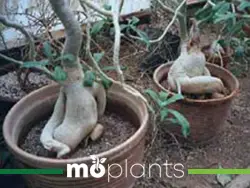
At the center of the garden stands a remarkable house constructed of concrete walls two feet thick to keep the heat of the desert summer at bay. Surrounding this lies the garden laid out in residential scale according to geographic regions of the world. Plants are grouped with others of their homeland. These regions include the Sonora desert, South Africa, Baja California and arid South America. The ability to view plants grouped not by their botanical classifications but by their natural distribution helps to illustrate important relationships and similar means of climatic adaptation.
Fig. 01: Many succulents develop fleshy stems and roots with sensuous forms that resemble human anatomy.
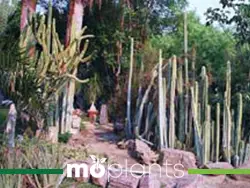
The exception is the “Cactarium”, a greenhouse that protects some of the most rare and unusual species from the brutal summer sun and plunging temperatures of winter nights in the desert. Here grow a diversity of species of cacti and succulents but the most unique plants are the caudiciform species which exhibit thickened root crowns (caudex) and stems resembling human anatomy. Also here are many species of Asclepiads or carrion flowers, the rare Aztecia, Gymnocalyciums, Alstromeria, Euphorbia and Ferocactus. There are also two fine examples of Welwitzia mirabilis, an exceedingly rare plant from the Namibian deserts of southern Africa.
Fig. 02: The garden features a huge petrified tree trunk, fossils and organpipe cactus.
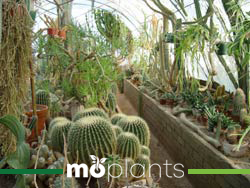
What makes Moorten Botanical Garden so wonderful is the age of its plants and their density on this relatively small site. Specimens here reach monumental proportions and bloom in abundance just as they do in the wild. Monstrous agaves, crested Cereus, towering cardon and exotic boojum trees, and are truly breathtaking specimens from the Americas. Mature arborescent “candelabra” Euphorbia and a two story Pachypodium combine with a dozen different aloes of southern Africa and Madagascar. Rare species of desert trees such as thorned Caesalpinia and Bursera along with tropical bombax shade the collection from the cruel summer sun.
Fig. 03: Inside the “Cactarium” are some the most rare and unusual plants of this garden. Its unique construction brings the plants up close for detailed inspection.
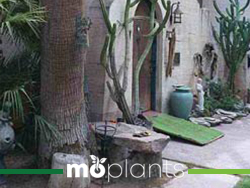
For many, one visit reveals only the surface of this many layered collection. A dozen pilgrimages later and you will notice new plants at every turn. While other public gardens offer a few outstanding specimens, the garden at Moorten’s is so generous it can be thankfully overwhelming.
Moorten Botanical Garden is located at the south end of Palm Springs. Hours are 9:00 AM to 4:30 PM Monday through Saturday; 10:00 to 4:00 Sundays. The garden is closed on Wednesday.
Fig. 04: The Moorten family residence and its grounds are available to rent for private parties and weddings.
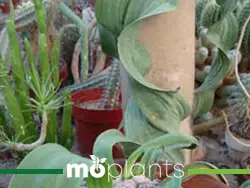
Fig. 05: Welwitchia mirabilis is believed to be a dwarf tree with only two leaves that grow like a long ribbon continuously from their base like human fingernails. This living fossil survives in that rainless region from moisture laden fogs that travel far inland from the Atlantic coast. Specimens in the wild can exceed 2,000 years of age. The plants are diecious gymnosperms, reproducing by cones, proving they are indeed quite primitive.
Moorten Botanical Garden – History
The garden is the legacy of two remarkable individuals, Patricia and Chester “Cactus Slim” Moorten. Both shared a love of the desert, its beauty, plants and wildlife. They are inextricably linked to the history and aesthetic of Palm Springs, the winter playground of Hollywood elite.
Nicknamed Slim for his tall lanky form and work as a contortionist, he was one of the original Keystone Cops. Slim became the stand in for Howard Hughes and played parts in many other movies over the years. Poor health led him to the desert in the 1930s with his young wife Patricia, a biologist with special interest in botany. Together they explored this desolate landscape and worked the Rainbow’s End Gold Mine in the high desert. They began collecting desert plants, historic artifacts and minerals early on and sold them at their shop. It stood at that is now the Spa Hotel in downtown Palm Springs.
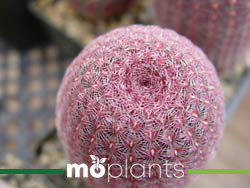
As the social milieu of Palm Springs grew in the 1940s, the Moortens became active landscapers, creating desert gardens around the homes of many of Hollywood’s most famous names. Adept at moving very large boulders, Slim was known for engineering the outstanding naturalistic waterfalls and pools. They designed and installed landscapes for Frank Sinatra and were good friends of Walt Disney at his Smoke Tree Ranch nearby. They were consulted by Disney to help design the western theme of Frontierland at his new amusement park which would later become Disneyland.
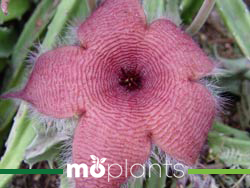
The Moortens were also well traveled and packed up their only son Clark for trips down Baja California and into Mexico collecting plants as far south as Guatemala. These adventures were extensive and they became familiar not only with the plants but the indigenous people and local wildlife. Many rare plants in the Moorten Botanical Garden were collected on these trips.
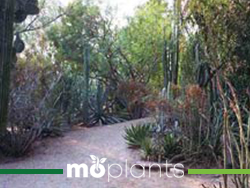
Clark Moorten is now the curator of this botanical wonderland. He is an expert in his own right and among the most knowledgable experts on succulent plants in America. He tends the garden and propagates many of its plants for sale and is there to greet visitors almost every day.
Fig. 08: Trails through this garden reveal an incredible density of species that takes a great deal of time to see in all its many layers.
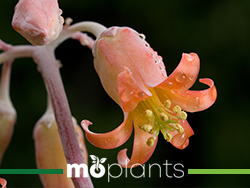
Moorten Botanical Garden is located at the south end of Palm Springs. Hours are 9:00 AM to 4:30 PM Monday through Saturday; 10:00 to 4:00 Sundays. The garden is closed on Wednesday.
Moorten Botanical Garden
1701 South Palm Canyon Drive
Palm Springs, CA 92264 (760) 327-6555
The premises may be rented for weddings and parties. Please call for price quote and information.


